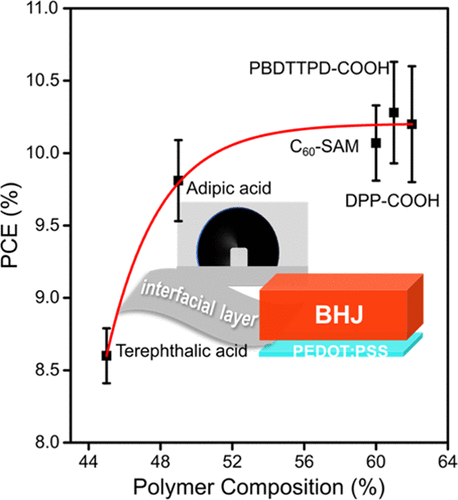当前位置:
X-MOL 学术
›
ACS Appl. Mater. Interfaces
›
论文详情
Our official English website, www.x-mol.net, welcomes your
feedback! (Note: you will need to create a separate account there.)
How to Choose an Interfacial Modifier for Organic Photovoltaics Using Simple Surface Energy Considerations
ACS Applied Materials & Interfaces ( IF 8.3 ) Pub Date : 2021-09-14 , DOI: 10.1021/acsami.1c12790 Dan Yang 1, 2, 3 , Bing Cao 1, 2 , Peter Müller-Buschbaum 3, 4
ACS Applied Materials & Interfaces ( IF 8.3 ) Pub Date : 2021-09-14 , DOI: 10.1021/acsami.1c12790 Dan Yang 1, 2, 3 , Bing Cao 1, 2 , Peter Müller-Buschbaum 3, 4
Affiliation

|
Organic photovoltaics are typically composed of at least four different materials, including the donor and acceptor components of the bulk heterojunction, the interfacial layers at each electrode, the electrodes themselves, and solution additives that may persist in the final sandwich structure. The interplay of surface energies between these different layers is profoundly complex, as the deposition and annealing of one layer on top of another may be influenced by the surface energy of these interfaces. While the energy levels of one layer with respect to adjacent layers are important to facilitate charge separation and collection at the electrodes, the relative surface energies of the interfaces in contact with the multicomponent bulk heterojunction can be beneficial or disadvantageous, or be neutral, with respect to the performance of the OPV device. Because the bulk heterojunction is a mixture of donor and acceptor polymers and/or small molecules, the accumulation of one of the components on the underlying electrode interface can be driven by surface energy considerations. A donor- or acceptor-rich interface may affect charge carrier flow to the electrode, thus affecting the overall efficiency. Here, ITO/PEDOT:PSS electrodes in forward organic photovoltaic devices are treated with five different thin interfacial layers to change the relative surface energy of this electrode with respect to the adjacent bulk heterojunction. Contact angle measurements with four probe liquids enable calculation of the surface energies, and the results are compared with the performance of forward-biased organic photovoltaic devices. Time-of-flight secondary ion mass spectrometry results substantiate the predictions of gradients in the bulk heterojunction layers, and grazing-incidence wide-angle X-ray scattering measurements show the impact on the polymer crystallites. Thus, a simple algorithm based on surface energy considerations may inform which interfacial layer for a given bulk heterojunction in an organic photovoltaic device can be the most appropriate.
中文翻译:

如何使用简单的表面能考虑为有机光伏选择界面改性剂
有机光伏通常由至少四种不同的材料组成,包括体异质结的施主和受主组分、每个电极的界面层、电极本身以及可能存在于最终夹层结构中的溶液添加剂。这些不同层之间表面能的相互作用非常复杂,因为一层在另一层之上的沉积和退火可能会受到这些界面表面能的影响。虽然一层相对于相邻层的能级对于促进电极处的电荷分离和收集很重要,但与多组分本体异质结接触的界面的相对表面能可能是有利的,也可能是不利的,或者是中性的,关于 OPV 设备的性能。由于本体异质结是供体和受体聚合物和/或小分子的混合物,因此表面能考虑可以驱动其中一种组分在下方电极界面上的积累。富含施主或受主的界面可能会影响电荷载流子流向电极,从而影响整体效率。在这里,正向有机光伏器件中的 ITO/PEDOT:PSS 电极用五种不同的薄界面层处理,以改变该电极相对于相邻体异质结的相对表面能。使用四种探针液体进行接触角测量可以计算表面能,并将结果与正向偏置有机光伏器件的性能进行比较。飞行时间二次离子质谱结果证实了本体异质结层中梯度的预测,掠入射广角 X 射线散射测量显示了对聚合物微晶的影响。因此,基于表面能考虑的简单算法可以告知有机光伏器件中给定本体异质结的哪个界面层可能是最合适的。
更新日期:2021-09-29
中文翻译:

如何使用简单的表面能考虑为有机光伏选择界面改性剂
有机光伏通常由至少四种不同的材料组成,包括体异质结的施主和受主组分、每个电极的界面层、电极本身以及可能存在于最终夹层结构中的溶液添加剂。这些不同层之间表面能的相互作用非常复杂,因为一层在另一层之上的沉积和退火可能会受到这些界面表面能的影响。虽然一层相对于相邻层的能级对于促进电极处的电荷分离和收集很重要,但与多组分本体异质结接触的界面的相对表面能可能是有利的,也可能是不利的,或者是中性的,关于 OPV 设备的性能。由于本体异质结是供体和受体聚合物和/或小分子的混合物,因此表面能考虑可以驱动其中一种组分在下方电极界面上的积累。富含施主或受主的界面可能会影响电荷载流子流向电极,从而影响整体效率。在这里,正向有机光伏器件中的 ITO/PEDOT:PSS 电极用五种不同的薄界面层处理,以改变该电极相对于相邻体异质结的相对表面能。使用四种探针液体进行接触角测量可以计算表面能,并将结果与正向偏置有机光伏器件的性能进行比较。飞行时间二次离子质谱结果证实了本体异质结层中梯度的预测,掠入射广角 X 射线散射测量显示了对聚合物微晶的影响。因此,基于表面能考虑的简单算法可以告知有机光伏器件中给定本体异质结的哪个界面层可能是最合适的。











































 京公网安备 11010802027423号
京公网安备 11010802027423号